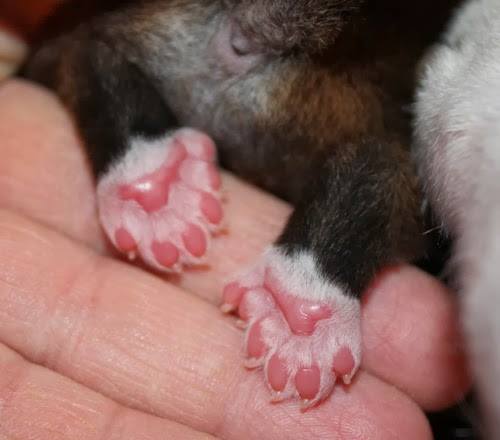
What do you notice about this photograph?
Sharp eyed readers will notice six toes – and since very few dog breeds boast being Polydactyly, the breed to which these toes belong is known to many of you.
Here’s what you probably already know about the Norwegian Lundehund, a Polydactyly breed:
Six toes: ✔️
An extremely flexible neck to the extent that their heads can tip backward and touch their backbones: ✔️
Ears that can close shut: ✔️
Puffin hunter: ✔️
A breed that went this close to extinction: ✔️
If you’re a dog “geek,” you also probably know that the breed was this close to extinction at one time. If you’re a hopeless dog geek, you know that if it wasn’t for the seclusion offered by the fishing villages of Værøy and Lovunden, the Lundehund might have disappeared forever. Isolation has probably preserved more breeds than it has harmed.
Experienced breeders of English Setters, Eleanor Christie and her husband, read an article by Sigurd Skaun about the Lundehund and decided to try to help reestablish the breed. The pair got their first dogs from Mastad, and it was through their efforts that the breed was saved: Their kennel, named Luxor, ultimately boasted more than sixty Lundehunds.
We’ll save for another article how the lack of distemper vaccine during the Second World War devastated the entire Lundehund population in Norway. Suffice it to say that when a 70 year old Eleanor Christie decided to breed Lundehunds one more time (this after the loss of her husband), her decision came just in time. There were few Lundehunds left, and in 1960, it shocked breed enthusiasts to learn that there were but six purebred Lundehunds remaining – five on the island of Værøy, and one on the island of Lovunden.
In time, a Swedish geneticist would be recruited to fashion a breeding plan that called for the inclusion of all viable males to produce a restricted number of progeny (this number grew as the population grew). The plan was adopted by the Norsk Lundehund Klubb Breeding Council to help bring the Lundehund population back to greater numbers, and as far as we know, Norwegian breeders followed these guidelines for at least two decades.
By the way, with regards to the breed’s flexibility, did you know that a show judge should never ask a dog’s handler to demonstrate that legendary flexibility in a show ring, largely because many dogs can’t sufficiently relax at a dog show.
This photograph was sent to us years ago, but without credit. We’d love to give credit, anyone?

For an unknown reason the link to the nlaainc.com link isn’t working. I’ve tried to access the web site using several different browsers without success.
Our apologies, Lynn. We couldn’t get the link to work, either, and it appears that the site is now defunct. We’ve removed the “live” link and apologize for the inconvenience.